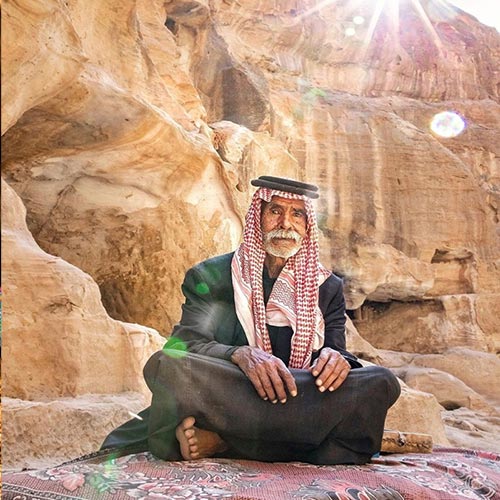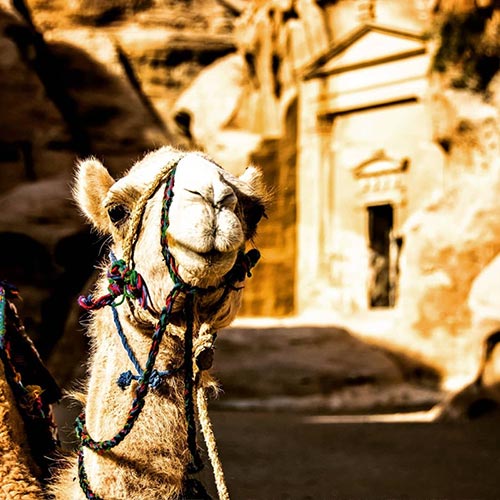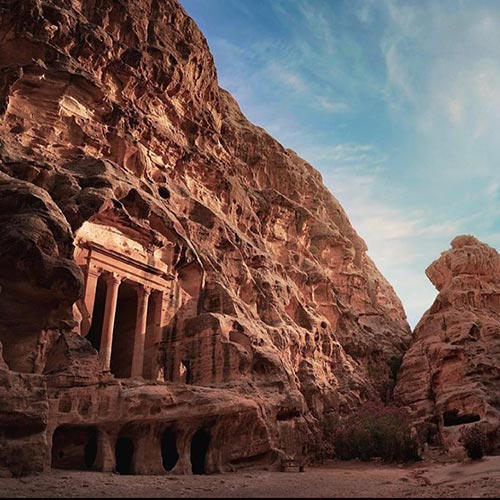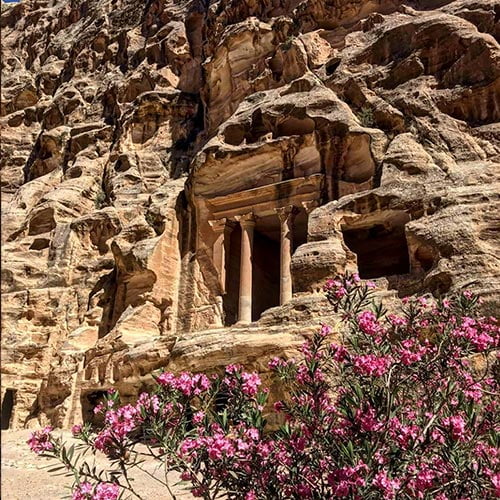Little Petra sits in an arid, mountainous region about 3,410 feet above sea level. To the east are the open expanses of the Arabian Desert and to the west is rugged terrain that descends into the Jordan Rift Valley and eventually winds around the Dead Sea.
Unsurprisingly, Little Petra lies only a short distance from Petra, a large archaeological park that’s probably the most famous tourist destination in Jordan. It’s believed that Little Petra was once a suburb of Petra, as they both date back to around the same time. In fact, some historians believe that some of the elaborate dwelling carved into the canyon walls in Little Petra actually belonged to some of Petra’s more successful traders.




Culture & History
It’s commonly believed that Little Petra was established in the 1st century as a suburb to Petra. This was when the Nabataean culture was at the peak of its power. Petra was an important city in the spice trade, and it is believed that Petra was home to the larger city’s most illustrious merchants. It’s unknown what happened to Little Petra when Petra was abandoned in the 7th century – but at some point, Little Petra was also uninhabited and remained that way for 1000 years.
Little Petra was unknown to most of the world except for Bedouin nomads, who would sometimes camp there. When Swiss traveler Jacob Burckhardt visited Petra in 1812 and introduced the Western world to the ancient city, he didn’t venture north to Little Petra. Most of the Western visitors that came soon after him also focused on the larger city.
But in the late 1950s, British architect Diana Kirkbride expanded her excavation at Petra north to include Little Petra, and it continued all the way through 1983. And when UNESCO designated Petra a World Heritage Site in 1985, the honor extended to the surrounding area, including Little Petra.
Tourism to the area spiked significantly after the release of Indiana Jones and the Last Crusade (1989), which has major scenes that take place in Petra. To make sure the area stayed maintained and preserved, the Petra Regional Authority was created. And while Little Petra was included in these protections, it operates completely separately from the larger Petra Archaeological Park.
Things to See
Little Petra is open to the public during the day and, unlike the larger park, admission is free. It’s less crowded and therefore a bit more relaxed. You may even see Bedouin herders leading their stock in to drink from the water at the cisterns.
And while many make a stop at Little Petra after spending most of the day at Petra, but the smaller city is well worth a visit on its own.
One unique place to visit in Little Petra is the Painted House. It was discovered during the excavations in the 1980s but wasn’t made public until 2010. The painted fresco was hidden under years of soot from Bedouin campfires and was restored by London’s Courtauld Institute of Art in 2007. The mural seems to be paying homage to winemaking and consumption and includes three different species of grapes, two birds, a cherub playing the lute, and many varieties of flowers and leaves. The Painted House is not only beautiful, but it’s also considered historically significant. It’s believed to be the largest surviving piece of Nabataean art in existence.
Things to Do
When visiting Little Petra, you’re free to wander around on your own though hiring an experienced guide is recommended. You can easily take a self-guided hike around the area. But to learn as much as you can about what you’re seeing, hire a guide.
If you wish to expand your visit beyond Little Petra itself, there’s a short fifteen-minute hiking trail that begins just left of the entrance. Follow it and you’ll find the Neolithic ruins of Al Beidha, an archaeological site that dates back 9,000 years. This dwelling was believed to originally belong to a hunter-gatherer society due to the layout of the hearths and roasting areas as well as a lack of any evidence of permanent buildings from this time period.
Evidence also suggests that the area was then farmed by a group who used stone masonry and built walls around the settlement as well as subterranean floors. It’s believed that inhabitants during this time herded goats, grew barley and wheat, hunted other species of wild animals, and gathered things like fruit and nuts. A burial area was also discovered, indicating that this was a somewhat permanent home. And while it was destroyed by fire around 6,650 BC, it rebuilt yet again with rectangular buildings and specialized workshops.
At one time, it was believed to support up to 235 people.
Al Beidha is historically significant because it contains physical evidence of the transition from hunting and gathering to farming and raising herds. It also demonstrates the emergence of right-angled buildings and an onsite temple, which suggests the practice of a pre-Abrahamic religion.
Ideal Time to Visit
Little Petra and the surrounding areas can be visited at any time of the year as long as you carefully prepare for the weather. Spring and fall are the best times to go because both the temperature and rain are much less extreme.
Alternative Times to Visit
Summers in the region are particularly hot and dry so make sure you dress appropriately. Sunscreen is essential and a good skin moisturizer or protectant is recommended because the air is also really dry.
Winter months are warm during the day but the temperature can drop significantly at night. Make sure you bring along gloves, hats, and coats. Also, avoid visiting Little Petra on rainy days, as torrential downpours in the winter months are fairly common.
